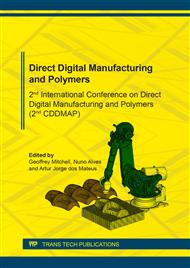p.3
p.21
p.34
p.43
p.54
p.61
p.70
p.77
Study of Metal/Polymer Interface of Parts Produced by a Hybrid Additive Manufacturing Approach
Abstract:
The additive manufacturing of multimaterial parts, e.g. metal/plastic, with functional gradients represents for current market demands a great potential of applications [1]. Metal Polymer parts combine the good mechanical properties of the metals with the low weight characteristics, good impact strength, good vibration and sound absorption of the polymers. Nevertheless, the coupling between metal and polymers is a great challenge since the processing factors for each one of them are very different. In addition, a system that makes the hybrid processing - metal/polymer - using only one operation is unknown [2, 3]. To overcome this drawback, a hybrid additive manufacturing system based on the additive technologies of SLM and SL was recently developed by the authors. The SLM and SL techniques joined enabling the production of a photopolymerization of the polymer in the voids of a 3D metal mesh previously produced by SLM [4]. The purpose of this work is the study on the metal/polymer interface of hybrid parts manufactured from the hybrid additive manufacturing system [5]. For this, a core of tool steel (H13) and two different types of photo-polymers: one elastomeric (BR3D-DL-Flex) and another one rigid (BR3D-DL-Hard) are considered. A set of six samples for each one of metal core/polymer combination was manufactured and submitted to tensile tests.
Info:
Periodical:
Pages:
34-42
Citation:
Online since:
April 2019
Authors:
Permissions:
Share:
Citation:


